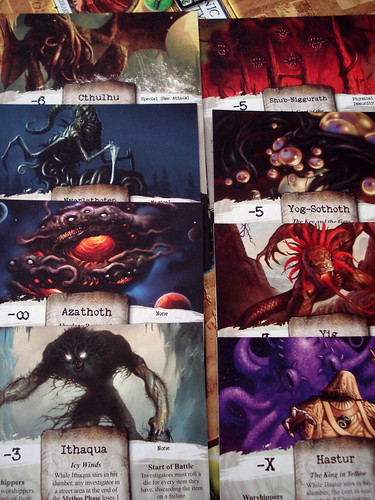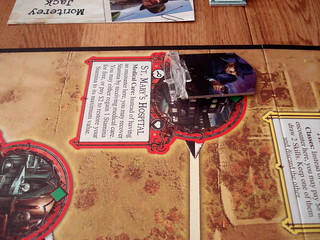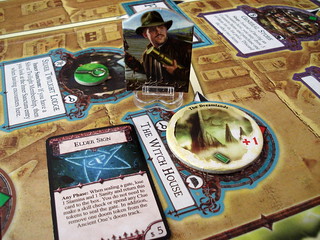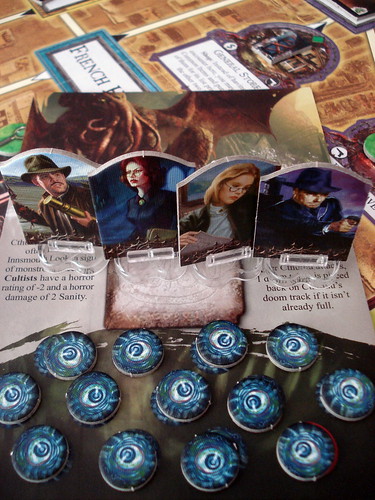| Strategy | Luck |
|---|---|
| Interaction | Components & Design |
| Complexity | Score |
It’s almost two years now since we took an excursion into Lovecraft’s Mythos with the Witch of Salem review. Now we’re going back into the world created by this unusual author with his penchant for ominous sounding words – like squamous, foetid or effulgence – and will talk about Arkham Horror, the most famous boardgame set in that particular universe. The town of Arkham is widely considered the most unlucky town in modern history. Whenever something weird happens, the walls of the multiverse break down, dark cults pop up, Arkham is where it happens. Even Great Old Ones supposed to be sleeping in the deepest trench of the ocean stir in their slumber and go for delicious screaming human breakfast waffles at the International House of Paincakes, Arkham. And that’s exactly where the problem lies, because some old god or the other is suffering from a sudden bout of insomnia, and where else would he go but Arkham?

Not only in character setup but in everything, Arkham Horror creates replayability with randomness. The stacks of item cards and random encounters are big enough that you can never rely on a specific one to show up in your game. Speaking about the game, after all this setup we can finally start playing. And the horror starts with a gate to another, unfriendly dimension opening in a random place in Arkham and a monster, also random, coming through it. That’s when you, the investigators, know that something is wrong. Gates like that don’t open unless something is seriously broken with the multiverse. And so you go and investigate.
Arkham Horrors turn structure is slightly different from the standard cooperative structure of “player moves – game moves – next player moves”. Instead, each round is split into phases that every player performs before the next phase starts. First, all players move. Movement is one of the (few) things not random in Arkham Horror, you walk as far as your speed attribute lets you. Arkham has two kinds of places: streets and locations. Streets are mostly boring in a leading-from-one-place-to the-other kind of way, but with every gate opening they fill up with monsters. Locations – like the Church, the Unvisited Isle and even the Bank of Arkham – have more interesting random encounters in the Encounter Phase. Monsters, interestingly enough, don’t count as encounters. When you not-encounter them in the streets you either sneak past or you fight them – both options are a total dice-fest, fighting more so than sneaking – and then either keep going after sneaking or take their heads as trophies after you win the fight. No one in Arkham minds you walking around with a bag full of monster heads dripping ichor all over their carpets, by the way, they are used to that kind of thing.

Fighting and sneaking – like everything else with dice in Arkham – follow an easy system: you roll a number of dice determined by your attributes, items and skills, and every five or six counts as a success. Score enough successes and you pass the test, obviously more easily managed when you get to roll 20 dice. And if those are still not enough you can spend clue tokens, collected from most locations on the board, to buy even more dice. While items and skills give you bigger bonuses, your basic attributes are also not set in stone and at the start of each turn you get to adjust them to prepare for the challenges that lie ahead. The attribute system is simple and yet clever, forcing you into trade-offs but not requiring much thinking. The six attributes come in three pairs, and in order to raise one you have to lower the other. Want to be faster, you have to be less sneaky. The other two pairs are less obviously linked- Fight vs. Will and Lore vs. Luck – but the rules don’t care.
After the fighting is done, all players that are not out in the streets get a random encounter. Each location in Arkham has it’s own list of random encounters in a pile of cards, and every location has some encounters that are beneficial and some that are less so. You might get a reward in the form of items, money or clue tokens or you might get eaten by a grue. Sometimes both things are linked to further dice-rolling. Some locations also let you have a not-so-random encounter, the various shops for example let you buy items – from a random selection – as your encounter. At the bank you can take a credit, at the Police Station you can be deputized. The options you have are almost endless, and that makes the first few games or Arkham Horror quite challenging because you can’t decide what to do. But all those options are only available if there is no gate at the location because, if there is, you get sucked through into a hostile lovecraftian world, like the Dreamlands or Yuggoth. Used to be a great vacation location, Yuggoth, but it really went into decline in recent aeons.

Being sucked into another world sounds like a really, really bad idea to everyone with their sanity intact, but it’s also absolutely necessary to save Arkham. Once you survived two random encounters there – drawn from another stack of cards but not so different from encounters in Arkham – you pop back out of the gate and can then try to close it. With more dice-rolling, of course. Closing gates is one of the ways to win at Arkham Horror: if no gates are open and you have at least one trophy from closed gates per player, you win. When you close a gate you have the option to seal it with enough Clue Tokens or one of the rare Elder Signs , making it impossible for another gate to open at the same place. Seal enough gates, you also win.
Sounds easy, right? Nothing bad happened so far. That’s what the Mythos Phase at the end of each round is for, make things hard for you. Cards from the Mythos deck have many, many different effects, and you’ll like very few of them. All of them open a gate in a random location, with a monster popping up right away. Except if that location has a gate already, then you just got a monster surge. Congratulations, all open gates will now spew more monsters. Monsters also move according to symbols on the cards, randomly and with different movement rules depending on the type of monster. And to round it off, each Mythos card also comes with another unique effect. Some are as mundane as fog – making it easier to sneak – or the neighbourhood watch cleaning up a district of Arkham and killing all monsters. That specific one has always bugged me a little: us investigators are risking our lives and sanity here and the neighbourhood watch could just clean up the city if they set their mind to it. What does it take for these guys to mobilize if the end of the world is not enough? But some Mythos Cards – Rumor Cards – are more nasty and add an additional quest to the game. Pass it and all players earn a reward, fail and really bad things happen.
And when too many really bad things happen, then all your efforts might not be enough and the Old One wakes up. But not all is lost, while he’s still rubbing the sleep from his eyes he’s vulnerable and you can beat him back down. It’s my least favourite way to end the game because you fight the Old One the same way as any other monsters, only he takes much more punishment before he falls over. We’re not talking dice-fest here, this is a dice-orgy of Roman Empire proportions, we’re talking twenty minutes of dice-rolling. Except if all investigators die at the start, then it’s quick.

To get to this point in the game, however, you can estimate 30 minutes per player. Three to four players is okay for that, but we tried our very first game in eight players and it was a total disaster. It’s not only that the game lasts forever but also that four out of eight players feel like they have nothing useful to do on any given turn. More than four players: not recommended. Another time-problem for Arkham Horror is the 3-4 days it takes to read the manual and the 30 minutes it takes to find anything in it. The rules are not really complex, but there are some special cases and some numbers you have to look up, and the rulebook can drive you insane more quickly than the Necronomicon in the audiobook version read by Shub-Niggurath. I’m not exaggerating here, read any online discussion on bad rulebooks and Arkham Horror will come up.
Between bad rulebook and lots and lots of randomness, however, there is something about Arkham Horror that just reading about it doesn’t get across easily: once you figured out how to play, it’s a lot of fun. The game manages to tell a story every time. All those options that you have, all the random encounters, they come together into an adventure, especially when playing with people who get into character. It’s great, once you managed to get started. In game-mechanics, Arkham Horror is actually a pretty easy game to win, much less challenging than Pandemic or Ghost Stories. If you waste a turn doing useless things in Arkham Horror, it’s not a big deal. Some rounds, you just can’t find anything useful. But telling the story is clearly the focus of the game, the story is what makes it tense. Tension is not in the game because every move counts, it’s there because of the Lovecraftian story. I don’t want to fall into clichés here, but Arkham Horror is a classical example of an American board game, its goal is to tell an epic story, with loads of components and good looks as a bonus, and that it does extremely well.















